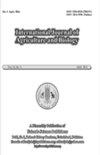1H NMR-Based Metabolomics to Identify Resistance-Related Metabolites in Astragalus membranaceus var. mongholicus against Fusarium Root Rot
Q2 Agricultural and Biological Sciences
引用次数: 1
Abstract
Root rot is a destructive disease of Astragalus membranaceus var. mongholicus (AMM) and occurs frequently in recent years in the main cultivation regions in China. However, the progress of AMM resistance breeding is extremely slow due to the lack of resistance source and inefficiency of the conventional disease resistance evaluation method. This study aimed to provide information on the interaction between AMM and Fusarium solani, one of the predominant pathogens causing root rot and identify the resistance-related (RR) metabolites by using the nontargeted 1H nuclear magnetic resonance (NMR) metabolomics approach. Of the 24 metabolites examined, the concentration changes in sucrose, fructose, taurine and phenylalanine were negatively correlated with the root rot severity. The abundance of malic acid in F. solani-inoculated samples considerably decreased at 21 days post inoculation (dpi). The five metabolites were identified as RR metabolites, and only malic acid inhibited the fungal growth. These metabolites might serve as candidate biomarkers for discriminating the resistance levels of different AMM genotypes and establishing the high-throughput screening method of AMM breeding lines against root rot caused by F. solani. Results could assist in accelerating the resistance breeding program. The possible mechanisms of RR metabolites in plant defense against the pathogen were discussed. © 2021 Friends Science Publishers基于1H nmr的代谢组学鉴定蒙古黄芪对镰刀菌根腐病的抗性相关代谢物
根腐病是黄芪的一种破坏性病害,近年来在我国主要栽培地区多发。然而,由于缺乏抗性来源,传统的抗病性评价方法效率低下,AMM抗性育种进展极为缓慢。本研究旨在通过非靶向1H核磁共振(NMR)代谢组学方法,提供AMM与引起根腐病的主要病原体之一茄镰孢菌之间相互作用的信息,并鉴定抗性相关(RR)代谢产物。在检测的24种代谢产物中,蔗糖、果糖、牛磺酸和苯丙氨酸的浓度变化与根腐病的严重程度呈负相关。在接种后21天(dpi),接种F.solani的样品中苹果酸的丰度显著降低。这5种代谢产物被鉴定为RR代谢产物,只有苹果酸能抑制真菌生长。这些代谢产物可能作为鉴别不同AMM基因型抗性水平的候选生物标志物,并建立AMM育种系对龙葵根腐病的高通量筛选方法。研究结果有助于加快抗性育种计划。探讨了RR代谢产物在植物防御病原中的可能机制。©2021 Friends Science出版社
本文章由计算机程序翻译,如有差异,请以英文原文为准。
求助全文
约1分钟内获得全文
求助全文
来源期刊

International Journal of Agriculture and Biology
AGRICULTURE, MULTIDISCIPLINARY-
CiteScore
1.70
自引率
0.00%
发文量
40
审稿时长
5 months
期刊介绍:
Information not localized
 求助内容:
求助内容: 应助结果提醒方式:
应助结果提醒方式:


